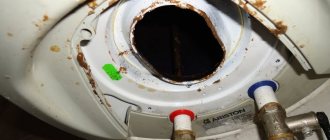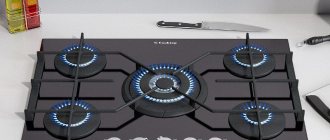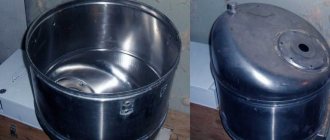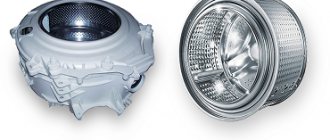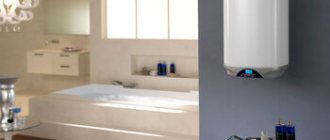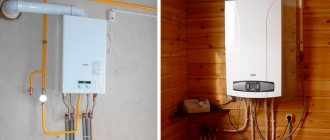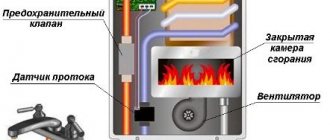Changes occur in our lives every year. But despite progress, hot water supply in high-rise buildings is often intermittent. In addition, the quality of the coolant itself does not always meet the standards. Therefore, many practical people have long ago installed their own water heaters in their apartments. They provide hot water to all apartment residents in the required volume. Therefore, it is necessary to choose the right equipment.
There are many recommendations for choosing this electrical equipment. The main selection parameter is its technical characteristics: power, performance, functional features. But besides this, you should pay attention to the material from which the inside of the tank is made.
How to choose the right inner lining for your water heater tank
Internal coating of a water heater tank - which is better?
Currently, manufacturers offer water heaters with 3 types of internal anti-corrosion coating:
- with titanium coating;
- stainless steel;
- from glass porcelain.
They reliably protect the container from corrosion processes. In other words, the lifespan of the device depends on the internal coating of the tank.
Which tank is better to choose a water heater with? These questions are often asked by buyers. It is impossible to give an unambiguous answer to this question. After all, each of them has its own pros and cons.
What are the similarities
- materials are made based on glass;
- both materials protect the walls of the container from corrosion and scale deposits;
- materials require careful handling during transportation, installation and during operation to avoid mechanical damage.
Conclusions:
Glass-ceramics undoubtedly has an advantage over enamel, since it is more durable and more reliably protects the walls of the container, although it is more expensive. Leading manufacturers declare a warranty period of up to 10 years for water heaters with a glass-ceramic coating, and this is true; for products with an enamel coating, the warranty period is approximately half as long.
Enamel and glass ceramics: advantages and disadvantages
Today, buyers give their preference to water heaters with glass porcelain coating. Such equipment is characterized by a minimal price compared to others. So, the advantages of these units:
- Profitable price.
- Preventive work to remove contaminants (sediment) on enamel coatings is easy to eliminate. To do this, just use a good detergent.
- Enamel is an inert material that is resistant to various chemicals. For example, only aggressive compounds such as hydrofluoric acid can damage the structure of glass ceramics.
Boiler with enameled tank and magnesium anode
The disadvantages of such an internal coating of the container include:
- The equipment faces the problem of good adhesion between the coating and the metal of the tank.
- Ceramic coating differs significantly in the composition of the metal from which the boiler itself is made. Often, due to constant temperature changes, materials separate from each other. But the use of glass ceramics in the production of equipment practically eliminates this drawback.
- The composition of bulk enamel may include coloring pigments. The latter often contain arsenic and lead - substances harmful to the body. But it should be remembered that devices manufactured over the last 20 years with a glass-ceramic tank do not have such a drawback.
- Ceramics is a fairly fragile material. Sudden shocks can lead to destruction of the coating. But this indicator is not important for permanently installed water heaters.
Interesting! Enamel and glass porcelain are particularly sensitive to temperature changes. This often causes the formation of microcracks on the surface.
To avoid this, some users use equipment by setting its maximum water heating temperature to 600C. But experienced experts recommend increasing the water heating temperature to maximum at least once a month to prevent the development of harmful bacteria inside the container.
The manufacturer's warranty for water heaters with enamel coating is 1 year.
Which material is better?
The manufacturer suggests a significant difference in coating materials. If tanks with a glass-porcelain coating are usually provided with a warranty of no more than 1 year, then for water heaters with a stainless steel tank, the period of performance guaranteed by the manufacturer ranges from 5 years or more.
This fact emphasizes the main advantage of metal over enameled glass porcelain - durability.
Indeed, enamel tends to deteriorate due to numerous temperature changes. Many developers apply various additional anti-corrosion layers to the inner surface of the enameled tanks of manufactured water heaters, but this cannot completely protect the ceramics from aging. Harsh working conditions, complicated by the low quality of supplied water, inevitably lead to the appearance of microcracks in the enamel.
For this reason, if your budget allows, it is best to opt for a device that has a water container made of stainless steel.
Stainless steel: advantages and disadvantages
Water heaters with an internal stainless steel coating belong to the category of expensive equipment. In principle, this affects their service life.
Stainless steel water heater
The advantages of boilers with this coating include:
- The coating is resistant to various shocks and damage compared to the above-mentioned model.
- Such water heaters are not afraid of temperature changes. If the equipment suddenly overheats due to the lack of liquid in it, it will not suffer. You will only need to replace the heating element and other parts that may fail due to high temperature.
- The service life of such boilers is longer than the models described above.
- The warranty period for containers with this coating varies from 7 to 10 years.
Disadvantages include:
- Stainless steel is characterized by its resistance to corrosion. But if a simple welding method was used, in this place the composition of the metal differs from the main one. The use of outdated technologies in the manufacture of equipment can cause oxidation on the seams. In addition, it should be remembered that all chemical reactions occur much faster at elevated temperatures.
- Many people remember the toxicity of iron, which comes into direct contact with water. But only divalent iron can have a negative impact on human health. Such a connection practically cannot be formed when steel comes into contact with water. In addition, examinations with ultra-precise instruments and methods did not show the presence of this element in large containers, except that the water itself could be its source.
- The price of equipment for heating water with a stainless steel coating significantly exceeds the cost of the models described above.
Plasma welding is used in the manufacture of a water heater tank
Conclusion
As can be seen from all of the above, choosing an enamel or ceramic water heater is difficult even for a specialist, not to mention ordinary consumers. Therefore, it is impossible to give specific advice on what is better. When choosing a heater, it is better to focus on the following factors:
- Parameters, characteristics and functionality of the device.
- Warranties provided by the manufacturer and their duration.
- Reviews from other people who have used a specific model of water heater and preferably in the same conditions in which it will be used in your place (even on the next street the quality and composition of the water may differ).
- As a rule, very cheap models are not very reliable. But you should not buy an overly expensive heater; it is not necessarily the best.
Titanium coated water heaters: advantages and disadvantages
Boilers with internal titanium coating are quite rare. They belong to a small class of devices. This lightweight and chemically resistant metal is applied electrostatically. As a result, the protective layer is highly resistant to corrosion processes and increases the strength of the equipment.
Due to the high adhesion and strength of the metal, the water heater can operate at high temperatures. This eliminates the risk of damage or peeling of the protective coating.
The weak point of the titanium coating is the welded joints. Corrosion often appears in these areas. And the cost of such equipment is quite high.
Boiler with two-layer titanium enamel
Glass ceramics
The birthplace of glass ceramics, otherwise called glass ceramics, is the USSR. This composite material was first discovered by the Soviet physical chemist Isaac Ilyich Kitaigorodsky (1888-1965). As a professor at the D.I. Mendeleev Moscow Art and Technology Institute, Kitaigorodsky devoted his entire life to the search for especially strong glass, and wrote a textbook on this topic, which was subsequently translated into several languages.
By combining starting materials, different types of glass and admixtures, the professor obtained a unique product used in a wide variety of industries. The professor's followers expanded the list of glass ceramics through experiments with different types of materials, various combinations of impurities and additives, and experiments with the proportions of the original raw materials.
Most glass ceramics are a range of materials that are distinguished by their strength and thermal stability; structures made from glass ceramics do not change their original size when exposed to high temperatures.
This coating is ideally suited for a metal water heater tank, since it does not attract lime particles , but repels them. The composition of the material prevents the formation of limescale build-up on the walls of the tank. The most famous example of glass ceramic is the surface of an electric kitchen stove.
The strength of the finished product is also influenced by the method of applying powdered sital to the metal. Today there are two methods: liquid and dry.
The liquid method is cheaper . That is why this method is often used in the manufacture of budget water heaters. The disadvantages of the liquid method are unevenness. Liquid tends to flow under its own weight, so the coating becomes thinner at the top and thicker at the bottom. The danger of a thin coating is explained by the presence of an aggressive air-water cushion at the top of the water heater tank, which leads to rapid corrosion of the material.
The dry method is more accurate ; glass ceramic is distributed evenly over the walls using electrostatic spraying. After firing at 90 degrees Celsius, the spraying firmly adheres to the surface of the tank and successfully protects the water heater from scale for 10-12 years, with proper care.
Tips for using porcelain glass water heaters
Such water heaters are considered the most common. Unfortunately, not everyone can afford to purchase expensive equipment. But with proper operation, you can achieve uninterrupted operation of the equipment over a long period.
- You should give preference to models with a magnesium anode. Its presence greatly reduces the activity of oxidative processes, which negatively affect the performance of equipment.
- It is necessary to periodically replace the magnesium anode.
- A coarse filter must be installed at the water inlet. Grains of sand and other particles that get inside the boiler can damage the surface from the inside when heated.
- Try not to overheat the tank. For domestic needs, water at a temperature of 50-600C is sufficient.
Preventive inspections and cleaning will extend the life of your device
- The water heater must be cleaned 2 times a year. This procedure will significantly extend the life of your device. At the same time, plaque is removed from the walls and bottom of the container, the heating element is cleaned of scale, the wear of the magnesium anode is checked and then replaced if necessary.
In stores today there are various devices for heating water. They differ from each other not only in functionality, but also in the internal coating of the tank: stainless steel, glass ceramics, titanium coating. Each of them has its own advantages and disadvantages. But regardless of the model you choose, you should remember that proper care is the key to long-term operation of the device.
User reviews about the best coatings
Dmitry, Volgograd: “I took a stainless steel water heater home for permanent use. Firstly, it will last longer, and secondly, the quality of water in Russia leaves much to be desired. But there is no desire to constantly change the magnesium anode.”
Ekaterina, Dnepropetrovsk: “We purchased a steel tank with an anti-corrosion enamel coating. It has been serving for a long time, both materials adhere well to each other, the container does not rust. Even if we heat water that is not of very high quality, it’s okay, the enamel can withstand even sea water. And this coating is not afraid of high temperatures.”
Konstantin, Omsk: “I spent a long time choosing between stainless steel and enamel. I settled on the last one. Enamel is practically the same as glass, that is, a chemically neutral material that does not react and does not cause allergies. The production technology of such water heaters has already been tested on thousands of models. Of course, from time to time it is necessary to carry out preventive measures, but where would we be without it.”
Important! Boilers whose internal capacity is made of stainless steel last longer. But, if financial resources are not enough, a glass-ceramic model is also suitable. True, you will have to strictly follow the operating rules and change components from time to time.
How to choose a water heater?
We go to Yandex.market (by the way, you shouldn’t always trust reviews) and mark the required parameters of the boiler. If any of the parameters is not clear, then by clicking on the question mark you can see a detailed description. Read a detailed article on the operating principle of a water heater on Wikipedia.
click on the picture to enlarge
On the Yandex market there is more detailed information in one place: boiler models, sellers, reviews, etc. The main thing is to choose options that suit you, then it’s easier to look in stores in your city.
Important! You should not trust all the reviews that are written on websites. The best thing to do is look for the negative ones and see if there are details there.
It’s just that laudatory ones don’t say anything at a minimum, and purchased ones at the most.
No. 4. Boiler tank shape
When deciding which boiler to choose, you can get so carried away by studying data on power, volume and material that you forget about much more obvious things. We are talking about the shape of the body. There are few options here, the body can be:
- round;
- rectangular.
Round barrel boilers tend to cost less (as they are easier to manufacture) but take up more space. This is the most popular version. Devices with a rectangular tank will save space, since they can be installed in a corner, niche, on the edge of a wall, or even hidden in a cabinet. Moreover, due to their shape, such models are equipped with a thicker layer of thermal insulation. There are also so-called slim models , in which the diameter or one of the sides is smaller than in standard devices. Before purchasing, it is very important to decide exactly where the boiler will be located and how much space is available for its installation.
As for color , there are few options. The most popular and win-win option is a white body. Gray and silver models are also in demand.
Enamel
Enamel is a protective coating made of glass with impurities , which is applied to metal at high temperatures. The glass for enamel must have a lower melting point than the metal on which it is applied.
Liquid enamel spreads in a thin layer over the metal and hardens as it cools. To achieve greater strength, the enamel is applied in several layers.
Having tested a water heater with an enamel coating for the first time, engineers found that such a coating is not reliable enough, since it does not tolerate high temperatures. When water is heated above 60 degrees Celsius, microcracks , which contributes to its rapid destruction, since the thermal expansion of the coating is strikingly different from the expansion temperature of the steel tank itself. Water heaters with such a coating rarely work longer than 3-4 years.
How to choose a water heater
There is no definite answer to which water heater you will need personally for your needs, since manufacturing companies offer devices whose designs are implemented on the same operating principles as those of competitors.
What factors should be considered when choosing a water heater?
- Heater type. The storage water heater is equipped with a thermally insulated tank in which water is stored. The instantaneous heater is more compact and provides hot water as needed. Such a device is more economical, but provides a limited flow per unit of time.
- Source for heating water. Gas boilers require less energy and are more budget-friendly than electric ones, although they may be more expensive at the time of purchase. Indirect heating devices need to be connected to a separate heating boiler, which complicates installation. Solar heating systems are also available.
- Storage water heater capacity. To determine capacity, consider the number of people in the family, shower and bath costs, and the presence of water-consuming appliances such as a washing machine and dishwasher. In order to heat the water to the required temperature, the storage device will take some time. Once the tank is used up, you will also have to wait for a new batch of hot water.
- The amount of flow of water passed through an instantaneous water heater. The flow device does not have a container for storing hot water. The efficiency of such a heater is determined by the number of liters per minute.
Please note that some instantaneous water heaters are designed for a single water outlet and you will not be able to take a shower if dishes are being washed in the kitchen at the same time. Therefore, in a family of several people, it is more reasonable to provide a model adapted for several water supply points.
- Place for installation. Storage water heaters will require dedicated space to be placed vertically on the wall or horizontally under the ceiling. Drains are more compact and can be built directly under the sink sink. Models with very large tanks will require floor mounting.
- Top or bottom water supply connection. Depending on the location of the water heater, a specific connection type may be preferable. For example, if you need to build a heater into a cabinet under the kitchen sink, top piping is more convenient.
- Ignition method. Automatic ignition will turn on the device when the tap is opened. Piezoelectric or battery-powered ignition will require pressing a button to light the burner to heat the gas boiler.
- Power. For a storage water heater, high power means a fast heating rate of the tank. In the case of an instantaneous water heater, this parameter is important for maintaining the normal flow rate of the heated liquid.
Keep in mind that high-power devices will require the installation of a dedicated circuit breaker in the distribution panel, and sometimes a three-phase connection.
- Installation and connection of the device. Many types of boilers can be installed independently due to their simple installation. Find out if the heater service warranty is still valid if you install it yourself. Otherwise, contact the professionals.
What details can you ignore when buying a water heater?
- Anti-scale function. Some manufacturers advertise models with reduced formation of mineral scale that forms at the bottom of the tank during boiling. Although mineralization shortens the life of the heating element, you should not overpay for the operation of this device.
The service life of the heating element is primarily determined by the hardness of the water. The higher the hardness, the more often the heater will require maintenance.
- Mechanical or electronic control. Heaters with mechanical buttons provide limited adjustments, but electronic panels are not always sensitive to pressure with wet fingers. Some models are equipped with a remote control.
- Digital screen. This part is accompanied by electronic control and displays the current water temperature. Some models allow you to set an economical flow mode and individual heating temperatures for each family member using a timer.
- Antibacterial internal coating of the tank. This is rather a marketing ploy for storage-type water heaters, since if water is stored in a tank for a long time without use, the liquid will bloom. Therefore, if the water heater is not used for a long time, it is recommended to drain the water from the tank.
Differences and similarities
Enamel is the cheapest coating for a water heater. An excellent budget option that works without interruption throughout the entire service life declared by the manufacturer. The main disadvantage: it is destroyed by temperature changes and salts deposited on the walls. With such exposure, cracks will appear on the internal coating faster, and the service life of the product will be significantly reduced.
Glass ceramics - occupies the middle price segment of the boiler market . The quality, reliability and service life are higher than that of enamel, but the coating is very susceptible to mechanical stress. Fragile glass ceramics are installed very carefully and try to protect the device from any shocks and collisions.
Important detail: sellers and manufacturers are increasing the price of water heaters with glass-ceramic coating “Bio”, “Self-healing coating”, “Extra durable”, etc. This type of coverage is no different from ordinary coverage, and you shouldn’t overpay for it.
Both coatings, glass ceramics and enamel, protect the metal tank from rust, which significantly improves the properties of the liquid.
A water heater with any coating is destroyed by the salts contained in the water. The more salts, the less the device will last. The role of a magnet for salts is taken on by a magnesium anode, included in the package of any water heater.
The anode attracts salt molecules and protects the walls from corrosion, but collapses itself. Therefore, the magnesium anode is a consumable item that requires replacement every 12 months . If you do not change the anode, the service life of the water heater is also reduced.
The main difference between glass-ceramic coating and enamel is the heating time of the water. Glass ceramics have greater thermal conductivity, so in such a device the water will heat up faster and stay warm longer than in an enameled heater. The second difference is the price. Since glass ceramics last longer than enamel, the manufacturer gives it a greater guarantee, which is why it costs more.
Zirconium is often added to glass ceramics, which gives an additional antibacterial effect and is also not afraid of very hard water. Enamel, unfortunately, does not have a disinfecting effect, but it is inexpensive.
Proffi PH8840 – instantaneous non-pressure water heater
This super-compact non-pressure water heater, designed in the form of a mixer tap, is designed primarily for the kitchen and plugs into a standard outlet. The heating elements are located inside the housing. The power of the device is 3 kW, the temperature control method is by pressure: the lower it is, the warmer the water. The device is protected from overheating, splashes (four degrees of protection), switching on without water or with insufficient water pressure. The temperature maximum for this “baby” is impressive - 60 degrees. An important feature of the Proffi PH8840 is a filter for inlet water purification. The faucet with mesh aerator rotates 360 degrees.
Stainless steel hob
It is an alloy of several elements, the main one of which is chromium. The higher its content in the alloy, the higher its quality.
Gas hob Whirlpool AKR 361 IX stainless steel
We have long and repeatedly used kitchen utensils made of this material and therefore we know that stainless steel is different from stainless steel. It happens that the metal does not live up to its name and allows some corrosion. For a hob, the quality of steel is of paramount importance.
Hobs made of both matte and mirror high-quality steel look very modern, stylish and elegant.
This coating is perfect for both gas and electric panels.




